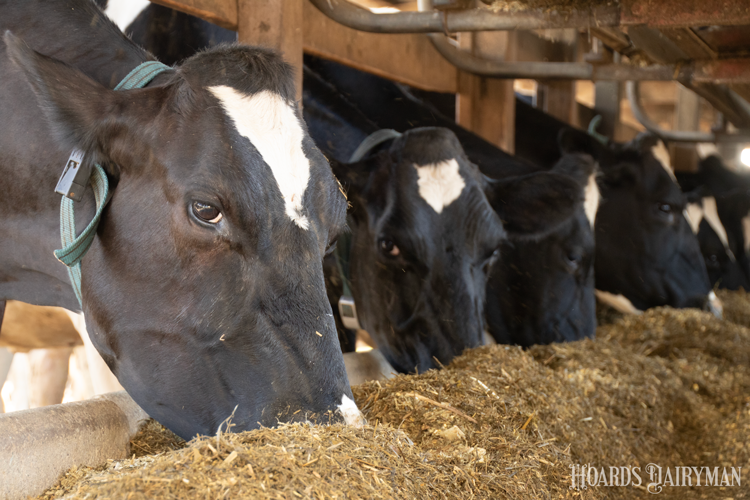Goeser is the director of nutritional research and innovation with Rock River Lab Inc., Watertown, Wis., and an adjunct assistant professor in the dairy science department at the University of Wisconsin-Madison.

Not long ago I opened a cupboard to grab a coffee mug and noticed a blue-green tint to a bread loaf on the middle shelf above the mugs. I pulled out the whole wheat bread covered in mold, read the “best by” date, and recognized this loaf needed a quick trip to the trash. Without trying a piece, one already knows the health and digestive issues that will come along with eating this rotting bread.
Moldy food and feed is easy to identify as spoiled. Feed hygiene, or cleanliness, on a dairy farm isn’t always this simple to spot, though.
A scientific intersection
Feed’s hygienic quality is defined by far more than what the eye can visualize and is attributed to numerous factors. I’ve introduced the feed hygiene diamond, pointing out there are four stress points and bases to cover: fungal, bacterial, nutritional, and environmental/management.
Herd digestive outbreaks are always multifaceted, though alleviating stressors in each of these areas will help us in our quest toward better feed conversion efficiency and lesser feed costs per hundredweight of milk. Every calorie a dairy cow spends on an immune response or digestive upset, including subclinical reactions, represents calories that don’t end up in the bulk tank and dollars missing from your milk check.
For example, Lance Baumgard’s Iowa State research has shown a sick cow may spend 4 pounds of corn grain energy supporting its immune system. Alternatively, think about how you feel after a cold or digestive illness finally subsides. You’ve likely been lacking energy for days to follow.
This feed hygiene issue comes back into focus as we approach warmer months. Some farms are realizing an uptick in fungal and mycotoxin contamination in corn-based feeds across the eastern half of the country.
With feed contamination comes an intersection between nutritional and veterinary sciences. Issues caused by bad feed can equate to veterinary care needs, especially if gastroenteritis or other severe clinical symptoms appear. Nutritionists and veterinarians need to come together in your herd’s defense.
Case in point, in the Hoard’s Dairyman April 2023 issue, veterinarian Angie Rowson and I co-authored an article discussing how to avoid mycotic abortions. Now, over the past couple of months, I’ve realized we need to expand this intersection between experts to include agronomists and plant pathologists.
Where it begins
Feed contamination often starts in the field. The feed hygiene diamond is similar to the plant disease triangle, which plant pathologists have used to describe critical control points in managing plant disease, namely the environment, the pathogen, and the host. With this in mind, agronomists and plant pathologists need to be part of your feed hygiene team.
The triangle and diamond come together because disease-causing organisms can be found in the soil and come with harvested feed. They can manifest at the feed center and feedbunk and then can be spread back onto the field. We need a whole farm system approach in some cases to break the cycle, with your agronomist, nutritionist, and veterinarian’s expertise coming together.
Creating a plan
The dairy industry continues to be exciting because dairy producers carry seemingly unmatched motivation, and we’re learning every day. Consulting agronomists share this drive and I often see how equally passionate they are about helping their dairy producers.
Expanding on the agronomist’s impact, several have reached out in discussion to better understand how or why mycotoxin contamination seems to be coming from apparently healthy crops and fields. I didn’t have a quick answer to this question, but I turned to University of Wisconsin-Madison plant pathologist Damon Smith for insights.
Smith shed light on this phenomenon, teaching us that asymptomatic fungal infections are likely the root of the issue. This was a watershed moment for me, realizing that visually healthy plants may still be afflicted with plant disease and subsequently mycotoxins. New management strategies can be implemented using the plant disease triangle.
Disrupting the plant disease cycle can be tackled by managing the disease triangle corners. With asymptomatic plant infections in mind, we can address the host or the pathogen.
Fungicide is one approach toward crop protection and reducing the pathogen. This strategy is not the end-all to plant disease or mycotoxins. Smith’s research lab has shown that fungicides can have an impact, but not all are created equal. We need a targeted approach.
Crop rotations are helpful to lessen the host sites available for disease-causing organisms to overwinter. Beyond crop rotations, hybrid resistance is rising in importance as a management tool. We’re to the point now that I believe plant disease resistance should be nearing the importance of yield and quality in our seed selection criteria. Our new goal in seed selection may be selecting for optimum clean energy yield per acre, with a multifaceted strategy including disease resistance, fiber and starch digestibility, and yield per acre.
Take these new insights into the cropping season to improve your feed quality. Make sure to include your agronomist or a plant pathologist in your strategic plan in this feed hygiene space, and remember there’s more to clean feed than your eyes can see.











